#u.s./mexico border
Explore tagged Tumblr posts
Link
“In the days after Title 42 ended Thursday, encounters between U.S. agents and migrants at the border dropped by half, a top Biden administration official said Monday.”
..not what I’m hearing from my buddies in border patrol.
7 notes
·
View notes
Text


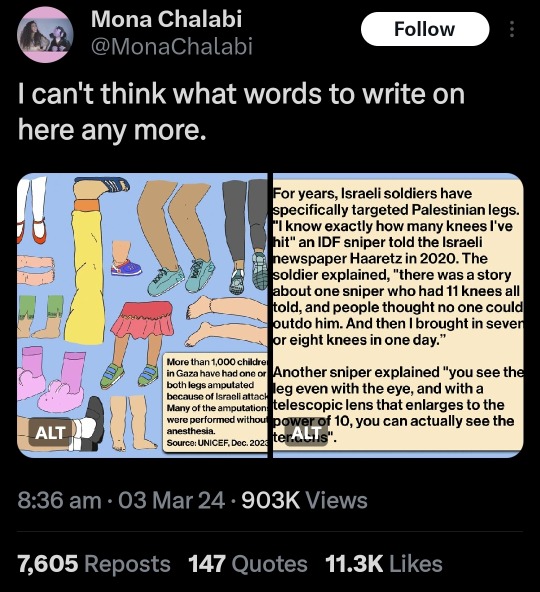
There's no coming back from this. There is no justification. This will always be their legacy. The world will never forget this and I won't let it.
#people who harm children don't deserve to have them.#I said this about what happened to the migrant children in the detention centers on the u.s/Mexico border#and I'll say it about what's happening to Palestinian children.#may both the nation-states responsible for these international atrocrities against children face the deepest consequences#dismemberment#amputation#mass disabling event#mass paedocide#violence against children#palestine#gaza#gaza genocide#disability#disability justice#war crimes#israel
4 notes
·
View notes
Text
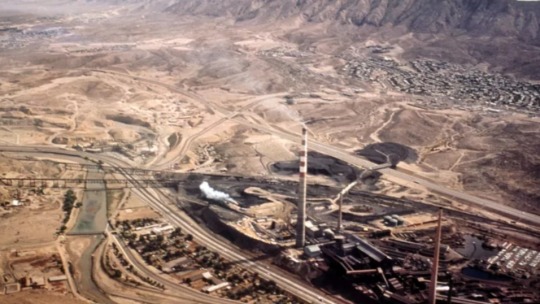
The air was polluted for three miles in any direction from the Asarco smelter plant, which was near the U.S.–Mexican border in El Paso, Texas.
After a 1970s CDC study showed that the mostly Mexican-American population of this Texas town had dangerously high blood lead levels, its buildings were demolished and its residents were booted.
The American Smelting and Refining Company owned a smelter in El Paso that, starting in 1910, refined hundreds of thousands of tons of lead and copper harvested from its mines in Mexico. It did so with the help of “an army of Mexican contract workers" according to a University of Houston associate professor of history.
Mexican workers who labored in Asarco mines began migrating north, lured by that new operation on the U.S. side of the border. Many settled on company land below the foothills of Mt. Cristo Rey. In the early years of the 20th century, Smeltertown lay outside El Paso city limits, a few miles from the city’s downtown.
By this time, Smeltertown had evolved from a small border town into an industrial hub for ASARCO. In 1900, Smeltertown had a population of 2,721. By 1920, the number grew to 3,119. Of this number, 95% were Mexican.
Smeltertown was designed by ASARCO to revolve all aspects of life around smelting. By creating a monopoly over labor in the town, the company could max their potential output for profit. To do this, managers needed an untainted focus on smelting at all hours of the day. Therefore, ASARCO strategically planned Smeltertown to invite and keep laborers.
The most enticing method in which ASARCO attracted foreign labor was company provided housing. Small tenement style apartments were constructed for all migrant employees. Located a short walk from the factory, it ensured that smelting was always on the minds of their workers. Homes lacked electricity, indoor plumbing, or furnished floors. These conditions were intentional. Not only did a lack of appliances keep costs cheap for ASARCO, it also kept laborers out of the comfort of their homes and therefore smelting more frequently.
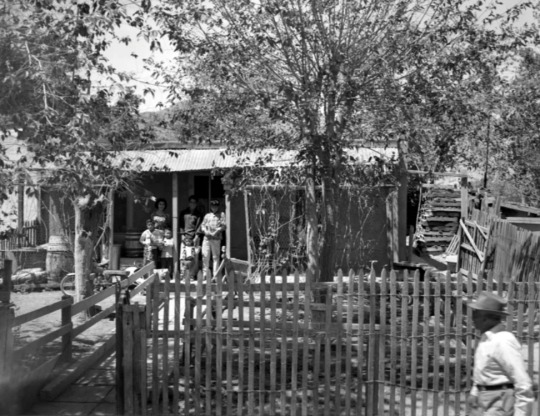
A home in Smeltertown, April 27, 1957, University of Texas at El Paso Library Special Collections Department, Cassola Studio Photographs, PH 041
Racial Hierarchy
Smtertown was divided into an upper section, El Alto, where the Anglo managers lived, and a lower section, El Bajo, where the Mexican workers lived.
Migrants were easily exploited by Anglos in positions of power. St. John describes, “The borderlands labor market was segmented by race… working-class ethnic Mexicans who labored as cowboys, miners, and smelter workers earned lower wages and were denied better-paying jobs in favor of Anglo-Americans and European immigrants."
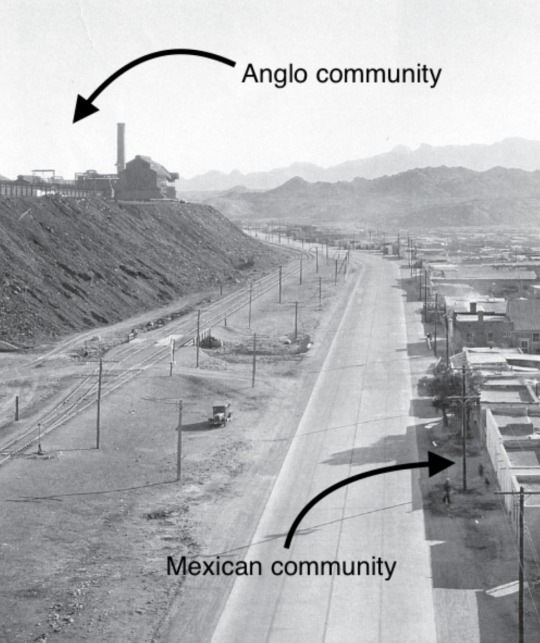
Poverty in Smeltertown could be extreme. Residents built and invested in their homes, but the company owned the land. As in other single-industry towns, Smeltertown’s residents fashioned their own way of life in the world the company made, one marked by inequality, racial segregation, and corporate paternalism.
This discrimination was most noticeable in the physical makeup of Smeltertown itself. Company owners and managers lived atop the hill in the gated Smelter Terrace, coined the "hidden oasis." These Anglos enjoyed paved driveways, green lawns, and swimming pools. A woman who grew up in Smeltertown notes, “I never went to Smelter Terrace, and I assume my mother did not either. There was no interaction between the workers and management children, I am now ashamed to say.”
On the contrary, blue collar immigrants lived at the bottom of the hill in adobe shacks that lacked running water and electricity. These row style living quarters were designed for single men working the smelting factory. Thus, when families followed along across the border, they were forced to squeeze into these tiny spaces. Children often slept on the dirt floors in order to fit everyone comfortably.
According to Daniel Solis, a former resident, “Smeltertown essentially was an eyesore for El Paso” an embarrassment to city officials and the company.
Sewage and water systems were built by the residents.
Daily Pollution Ignored by the City
The residents of Smeltertown also experienced the discomforts of living with ASARCO’s emissions on a daily basis. Sulfur dioxide, a major by-product of smelting, creates foul odors and can cause breathing problems and irritation of the eyes, throat and lungs. Daniel Solis recalls:
"In July and August … our folks would bring us into the house, because the smoke, the pollution, the sulfur, would settle into our community for about 2 or 3 hours every day in the mid-day when there was no breeze to take it away. When we would breathe that, we could not be outside because we were constantly coughing. So nobody can tell me that there was no ill effect on the majority of the folks that lived in Smeltertown."
Mary Romero writes that Smeltertown families tried early on to get the city to respond to problems of pollution.
Residents had organized in the 1950’s in an unsuccessful attempt to get the city to pave Smeltertown streets and thus control the dust problem. Several parents had sought medical attention for children born with brain damage and other illnesses; not one case, however, had been diagnosed as lead poisoning. Past attempts to label health problems as pollution-related illnesses had been unsuccessful.
Given the arduous work and poor living conditions, everyday lives of workers consisted of making the most of their situation.
ASARCO's company reign did not stop at housing. They constructed all resources necessary to function in Smeltertown in order to keep Mexicans from finding work elsewhere. Examine the list below to see all facets of life ASARCO controlled for their laborers.
Company Owned Estbalishments
Hospital
Supermarket
General Store
Jail
Post Office
A Closer Look: Company Store
The company store stocked items adapted to the needs of an isolated industrial community. Citizens could buy groceries, clothing, and even ship mail from the facility. The Smelter Store functioned by extending credit to workers that would eventually deduct from their weekly paycheck. ASARCO kept prices relatively high in comparison to their laborers' respective salaries in order to keep workers hungry for the money necessary to pay. Angel Luján, a former smelter explains, “it was like I owe my soul to the company store." Most laborers lived on a paycheck to paycheck basis due to this loan structure designed by ASARCO. To live a standard lifestyle in Smeltertown, Mexicans had to "sign away their paycheck and their lives" to the company.
“A Silent Poison”
In March 1971, a team of Epidemic Intelligence Service officers from the CDC arrived to investigate lead exposure connected to the Asarco smelter.
The El Paso City–County health commissioner, had called the CDC after his department discovered that Asarco was discharging large quantities of lead and other metallic wastes into the air. Between 1969 and 1971, the smelter’s stacks had spewed more than 1,000 tons of lead, 560 tons of zinc, 12 tons of cadmium, and 1.2 tons of arsenic into the atmosphere. Soil studies showed the highest concentrations of lead and other metals in surface soil closest to the smelter—essentially, in Smeltertown.
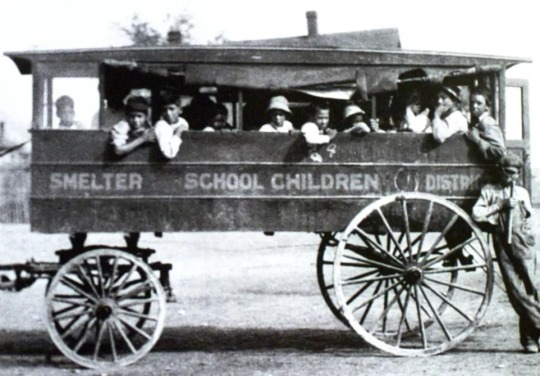
Smeltertown children on the way to school in a horse-drawn wagon, El Paso, ca. 1900, El Paso Historical Society
Although the CDC team found no cases of overt lead poisoning, 43 percent of people in all age groups and 62 percent of children 10 and under living within one mile of the smelter had blood lead levels of at least 40 micrograms per deciliter. That’s eight times the level at which the CDC recommends a full-fledged public health response today.
The CDC team quickly followed up with a second study in Smeltertown in 1972, examining the health consequences of lead exposure in children. The CDC team administered IQ tests and a finger-tapping test of physical reflexes to the Smeltertown kids with elevated blood levels; a control group of children with blood lead levels below 40 micrograms per deciliter was also tested. The study found that children with elevated blood lead levels tested as many as seven points lower on the IQ test than the control group; they also showed much slower reaction times on the physical reflexes test.
Initially, the families reacted to the disclosures of lead contamination with great concern and cooperated with the research teams and doctors who came to test and treat the children. Some children were taken out of the community to be tested—the 4 year-old sister of Daniel Solis was taken to Chicago, although, as Daniel recounts, “She had never been to the airport, much less on an airplane.” Most of the children were treated at local hospitals, using chelation therapy, a drug regimen designed to remove heavy metals from the blood. The treatment is painful, and can be prolonged.
Daniel recalls that his young siblings were terrified of the painful injections.
This is what scientists now know: Lead in the air or in dust, paint, or fumes can work its way into the human body. In children, lead can permanently damage the brain and nervous system. It can slow a child’s growth and development. It can cause learning, hearing, speech, and behavior problems. Studies—the Smeltertown study being among the first—have linked early-childhood lead exposure to reduced IQ, attention-deficit/hyperactivity disorder, juvenile delinquency, and criminal behavior, according to the CDC.
The consequences of early-childhood lead exposure can be moderated by educational enrichment, something that may not be readily available in poor communities with fewer opportunities and resources.
The pediatrician who led the CDC team stated, “I’m convinced one of the reasons our society has allowed it to go on is because the effects disproportionately fall on poor and minority children. In Smeltertown, people were almost universally immigrants from Mexico.”
During the trial, Ken Nelson, Director of Environmental Sciences for ASARCO, testified that lead contamination in Smeltertown had been “overlooked” by the company ASARCO officials said it had “never occurred” to them to include Smeltertown in the company’s air pollution monitoring system.
Asarco fought hard against the notion that the elevated blood lead levels in Smeltertown had anything to do with the smelter, or that lead exposure was harming children’s development.
The company claimed that elevated blood lead levels were caused by lead paint and gasoline emissions. It commissioned its own parallel study of the health effects in children and found no evidence of IQ loss. But the findings by the health department and the CDC team contradicted the company’s. The closer to the smelter the sample, the higher the concentrations of lead in the air, dust, and soil; human blood levels mimicked that pattern. And the CDC's team findings on the children’s IQ and physical reflexes were irrefutable.
It is worth noting that despite their groundbreaking nature, the study findings received little national attention at the time; A report by the New York Times in 1972 was the lone article that the newspaper wrote about Smeltertown.
As part of the settlement, the city and Asarco decided Smeltertown would be demolished, its residents forced to relocate. In October 1972, not two years after the lead studies began—eviction notices went out to all Smeltertown residents ordering them to clear out of their homes by January 1.
It should also be noted that the demolition of Smeltertown represented the least expensive solution for the city and ASARCO.
A statement by ASARCO’s physician that if Smeltertown had been allowed to remain, it would have required a greater commitments of funds and services than either the city or company was willing to provide.
The demolition of Smeltertown did not solve the problem of ASARCO’s emissions. Although the problem was first defined as a community health problem; it was later redefined as a problem specific to Smeltertown.
Restricting government action to Smeltertown fulfilled several objectives for various local interest groups. Business and industry were reassured that environmental policies would not threaten future growth. Pollution abatement would be placed second to economic stability, and therefore the chances of plant shutdowns or corporate flight were lessened … city and state officials were able to ignore contamination and possible health threats in other parts of Texas, New Mexico and Mexico.
Daniel Solis argues that the eradication of Smeltertown destroyed a significant part of Mexican-American history in El Paso. Like Romero, he points out that the solution chosen by the city and the company redirected attention away from the wider problems of contamination that was affecting children, workers and communities in the region.
The problems resulting from ASARCO’s emissions resurfaced continually over the years of ASARCO's operations in El Paso. Although the plant closed in 1999, the toxic contamination from ASARCO continued to be the focus of community struggles with the company, as community members pressed for information about the extent of contamination on both sides of the U.S.-Mexico border.
Everything that made up Smeltertown—every home and shop—would be bulldozed. Everything but the smelter itself, which would run for another 26 years.
Tight-Knit Comunidad
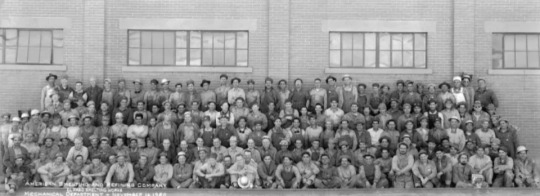
Mechanical department workers at Asarco, November 16, 1950
Outside of the work itself, laborers grew to establish unique cultural communities through their shared experiences. By mutually bonding over the challenges posed by the comany town, Esmeltianos banded together. Mexican migrants created their own binational "Mexican town" in Smeltertown.
Many Mexicans created their own Mexican establishments such as general stores, restaurants, and push cart vendors. Providing a wide labor market, El Paso inspired many Esmeltianos to extend their communities outside the company lines of Smeltertown. By 1930, various Mexican neighborhoods and establishments sprawled out in the El Bajo area, completely unaffiliated with ASARCO. One such example was the town YMCA, developed as a communal space for Mexican children to socialize and exercise. Efforts like these developed a deeper kinship in Smeltertown, away from the grave reality of smelting for a company. Instead, Mexicans claimed the borderlands as their own by branding cultural ties to the region.
Simple beautfication projects such as gardening gave citizens agency over the lives they lived in Smeltertown. Esmeltianos placed a large focus on simple tasks that emphasized aspects of life away from the company. Across the highway, many of the adobe shacks rented by the families were transformed with household money. They did not earn any home equity or even reimbursement for their efforts, just the pride in making a comfortable home for their families. In doing so, Smeltertown veered further and further away from the corporate grasp of ASARCO. Esmeltianos curated their community by naming streets and organizing sub barrios of El Bajo with Mexican influence. The combination of these efforts manifested into a town with a purpose far deeper than smelting.
What was originally intended to be a regimented camp strategized to produce maximum smelting output morphed into a binational community dense with culture. ASARCO may have owned Smeltertown, but it was its Mexican inhabitants that transformed the border town into a vibrant community.
Rubén Escandon has been collecting oral histories about the town for years from his own relatives and others as a member of the committee that protects Mt. Cristo Rey and the giant white cross Smeltertown residents erected at its peak.
“Everybody knew everybody,” says Escandon, who was born in 1965 in the satellite community of La Calavera, or Skull Canyon, near the Smelter Cemetery.
Gabe Flores, born and raised in Smeltertown in the 1940s and ’50s, remembers that the local señoras would pay him a few coins to walk hot lunches of caldo de res (beef stew), tacos, and fresh corn tortillas up the hill to the smelter men, who would be black with soot. When times were lean, Flores recalls, neighbors would borrow from each other: a little food, money, whatever was needed.
“It was all family,” he says. “Nobody was ashamed. Everybody was the same. Maybe they went through harder times and just realized they had to help each other. The fact that we would help each other, it bonded us together.”
Gloria Peña, an El Paso field nurse independently contracted to help with the lead testing in Smeltertown, recognized “the deep sense of loss” residents felt at the prospect of losing their community. “This is the beauty of our language because when you say ‘community’ it doesn’t have the same impact on us as if you say ‘comunidad.’ That is what Smeltertown had.”
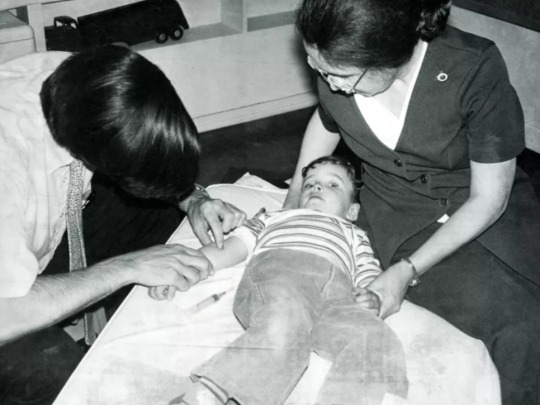
A blood test being prepared for one of 500 children being tested for blood lead poisoning, March 30, 1973
Former resident, Cecilia Flores Marquez stated about her three children, “When they were young, no [they did not have health issues]. But they are having issues now.” Her youngest daughter became allergic to metal in her 30s, she says—something the doctors say could be related to the lead exposure.
There were no long-term studies of the former residents of Smeltertown to measure the health outcomes of their exposure to lead. Today former residents are left guessing whether this or that disability, defect, or illness could have been caused by lead. They have no way of knowing for sure.
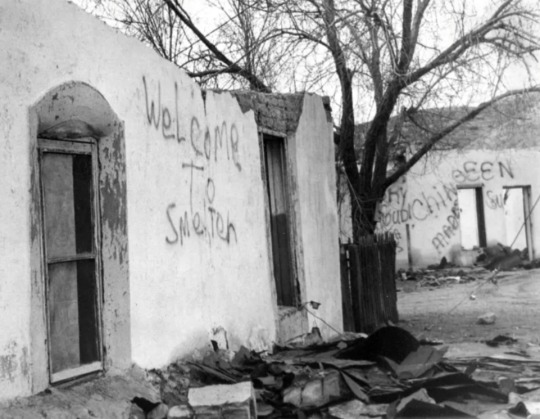
Smeltertown after it closed down, January 5, 1973
Asarco would run its smelter for another quarter century after bulldozing Smeltertown. It was not until the decline of world copper prices in 1999 that the smelter halted production and the company mothballed the facility, keeping only a skeleton crew on board. Ten years later, the smelter sat silently on the bluff, atop a century’s worth of hardened black slag.
Asarco’s towering smokestacks finally came down in 2013. Today there is almost nothing left of the company or Smeltertown but the slag-coated hillside and the graves in the Smelter Cemetery.
Sources: (×) (×) (x)
#🇲🇽#usa#united states#mexican history#history#racism#discrimination against mexicans#el paso#texas#American Smelting and Refining Company#mexico#mexican american#mexican#immigration#lead poisoning#ASARCO#smeltertown#CDC#new mexico#u.s. mexican border#hispanic#latino#latina#smelter#pollution#segregation#sulfur dioxide#air pollution#copper
8 notes
·
View notes
Text
Mexico: New Global Migrant Hub Amid U.S. Deportations
In an unprecedented turn of events, Mexico has become the unexpected sanctuary for thousands of non-Mexican migrants who have been deported from the United States under President Donald Trump’s aggressive immigration crackdown. This shift in policy has not only strained U.S.-Mexico relations but also positioned Mexico at the heart of a burgeoning global migration crisis. Here, we delve into the…
#Asylum seekers#Border crisis#Global migration#Mexico#Mexico migrant hub#Migrant rights#Non-Mexican migrants#Remain in Mexico#Trump immigration policy#U.S. deportations#U.S.-Mexico Relations
1 note
·
View note
Text
Grounded Diplomacy: Mexico Grounds U.S. Deportation Dreamliner
In an unexpected diplomatic hiccup, Mexico temporarily blocked a U.S. military plane from landing, complicating the Trump administration’s ongoing efforts to deport immigrants to the country, as reported by NBC News. While two Air Force C-17s managed to transport 160 deportees towards Guatemala, the planned flight to Mexico was grounded. The reason behind Mexico’s decision remains unclear,…
#border tension#border troops#Claudia Sheinbaum#deportation flights#diplomatic relations#Executive Orders#foreign affairs#Guatemala#Guatemalan nationals#immigration crackdown#immigration policy#Karoline Leavitt#Mexico#Mexico-U.S. relations#military aircraft#Ministry of Foreign Affairs#NBC News#remain in Mexico policy#sovereignty#tariffs#Trump administration#U.S. military plane
1 note
·
View note
Text

Did a google image translate of the bottom part and this is what I got! It’s about the Second French Intervention in Mexico when Napoleon III installed Austrian archduke Maximillian I (a member of the Habsburg family) to Mexico as emperor. Basically Frances’ attempt at installing an empire in Latin America while the U.S.A couldn’t enforce the Monroe Doctrine because it was busy with a civil war between the Union and the Confederacy.
I think the reason this historical event was talked about here is because the American Civil War was caused via a domino effect after the Annexation of Texas and the Mexican-American War during the 1840s, where the U.S. gained so much new land, causing dispute on whether the new states should be permitted to practice slavery or not which lead up to the civil war in the 1860s.
And you know looking at the bigger picture, all of this westward expansion from the U.S. from “sea to shinning sea” made it so that it became a global super power in part because of it’s strategic and advantageous geography.
* Note* - Mexico is a North American country, often mistaken as being a South American country probably because of people interchangeably misusing the term Latin America with South America. And I’m pointing this out because it might have been a mistake in the scanned booklet above.
American Civil War In Hetalia Canon

※1 At that time, black slavery was allowed in some states and wasn’t allowed in other states, and although Lincoln allowed the slavery in the Southern states, he was in opposition of its expansion in newly added territories of the USA. The reason why he declared the abolishment of the slavery was to get the support of England, as [England] have already abolished the slavery.

*Translator note: Untranslated section is about France aiding Mexico, not about the Civil War*
I was kinda shocked to learn about canon material about the American Civil War. I think even these 2 pages gives interesting information about America during the Civil War. I believe this pretty much confirms America was not split into two during Civil War.
I would really love to translate this whole book but I have no time for now TvT Hopefully when I have time at summer though would love to do it! Also yeah, that’s why the scanlation and editing looks terrible because I did it in a rush and not used photoshop.
I hope you enjoy it regardless!
#hetalia#scans#hws mexico#anyways I saw the Mexico and France and USA civil war yhing they kid the random Austria figure and immediately knew which historical event#this was referring to and I was right#this part of history was so fascinating like the possibilities and outcomes#that could have come about if one teansy tiny part of history was altered#plus this highlights how during this time Mexico’s and the U.S.’ histories are so closely tied together and how their modern day nations#really settled into themselves — so literally the foundation of their nations especially in terms of borders and geography#oh and nice to see Mexico mentioned of course they need to be canon!#considering they’re so crucial to the whole ‘discovery of the new world and age of discovery’#era with Spain kicking it off but who knows if we’ll ever see it
175 notes
·
View notes
Text
Mexico-to-US intermodal rail service
DP World, the international port container terminal operator, is beginning a new rail service from Mexico to the US for automobiles. It will use 53-foot containers to move the cars by truck or rail. That makes the containers compatible with the standard size container used in the US and Mexico as well, rather than the 40-foot ocean containers. That eliminates a need to transload for US road…
View On WordPress
#53-foot intermodal containers#Automotive assembly plants#Automotive logistics#DP World Container Packing#Finished vehicles#Logistics#Mexico-to-US intermodal rail service#Multilevel railcar capacity#Racking systems#Roll-on/roll-off capacity#supply chains#U.S.-Mexico border
0 notes
Text
Problems in U.S. Asylum System Help Promote Increases in U.S. Immigration
A lengthy Wall Street Journal article provides details on the well-known promotion of increases in U.S. immigration by the many problems in the U.S. asylum system. Here then is a summary of the basic U.S. law of asylum, the current U.S. system for administering such claims and a summary of the current problems with such administration. The Basic Law of Asylum On July 2, 1951, an international…
View On WordPress
#asylum law#Convention Relating to the Status of Refugees#Protocol Relating to the Status of Refugees#REAL ID Act of 2005#refugee law#U.S. asylum officers#U.S. Board of Asylum Appeals#U.S. Congress#U.S. federal courts#U.S. immigration judges#U.S. Office of the Chief Immigration Judge#U.S. Refugee Act of 1980#U.S. State Department’s U.S. Refugee Admissions Program#U.S.-Mexico border
1 note
·
View note
Text
A National Shame
Friends … I don’t even know where to start with this post. It’s rather like a Rubik’s Cube or a maze or some other puzzle that boggles the mind. I think maybe the best way to start is with a listing of some of the facts of the matter … the matter, by the way, being the situation at the Texas-Mexico border and the responses to it. So, here are the facts as I understand them: The number of…

View On WordPress
#Donald Trump#immigration#razor wire in Rio Grande#Texas Governor Greg Abbott#Texas-Mexico border#U.S. Constitution
0 notes
Text
As usual, the U.S. is not sending it's best people, but rather, it's worst.
1 note
·
View note
Text
My parents were very young when they had me and when they moved to the U.S. They didn't own a house yet. We lived in an apartment with 3 other families. The line to go to the bathroom was always long. I remember being 3 or 4 and having too many accidents because of it... I remember taking the bus and walking to school because we didn't have a car for a while. My dad entered work at 5am and worked until midnight. He got paid $5 an hour. My parents argued over money sometimes. Life wasn't overly difficult for us but it was different than what it is right now. It's just weird that my siblings don't know that other life our family had. My siblings NEVER had to experience our old way of life. I wish they did, it builds character lmao.
Now I have to work hard to make my parents proud and give them experiences they never had. Oh and I am forever the family translator (but I am slowly forgetting my first language and it sucks).
#this country and this city in particular#has been good to us#i wish everyone had access to these opportunities#it was just a combination of hard work and alot of luck#and now i can pay them back a tiny bit by having them experience europe with me#well. just my mom. cuz my dad was too scared. and he doesnt like italian food lmao#only my sister is going. my brother didnt want to go!#that ok. it will be so fun. ive never been on a plane before. never left his continent or been to another state#except over the border to mexico#also i hate when i go to mexico and they use the weirdest slang... like broooo?? que dices????#no but this country has grabted us a way to a better life. we are not rich. i still live with my family lol :( but we are comfortable#granted#***at the same time: i know things in the u.s could be alot better!!!#also. my peers are sooo individualistic. they dont consider their family when making major decisions which is very wild to me#not a bad thing! we just have different cultures and upbringings#... also sad abt the fact that my cousins are having kids and the kids dont speak spanish 🥲
0 notes
Text
Environment: Every Drop Counts in America’s Waterways Crisis
The Rio Grande and Colorado Rivers are two of the most threatened rivers in the U.S. National Geographic Photographer Pete McBride is on a mission to protect these vital rivers and their ecosystems.
— July 25, 2023 | Photographs By Pete McBride | By Kathleen Rellihan
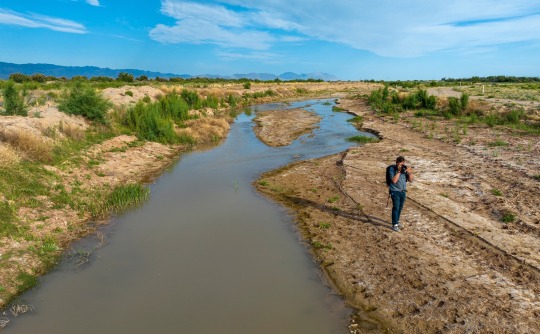
National Geographic Photographer Pete McBride went on assignment to the Rio Grande to capture imagery of the depleted waterway.
Our nation's most vital waterways are drying up at an alarming rate due to global warming, increased human water use, and other man-made impacts. Nowhere is this crisis seen as dramatically than in the American West, with its longest drought in 1,200 years. Two of our nation’s critical lifelines—the Rio Grande and the Colorado River—are shrinking tragically with every passing day.
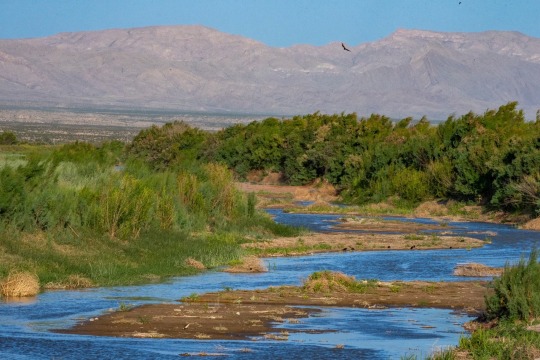
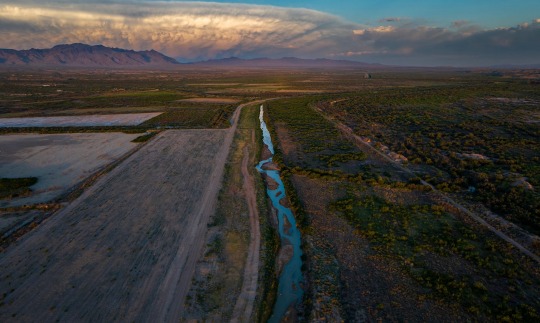
The Rio Grande is one of the most threatened waterways in the United States.
After spending years traveling the world on assignment, National Geographic Photographer Pete McBride realized that the world’s natural places he spent years documenting were changing drastically due to the disappearance of freshwater. He has spent the last two decades trying to bring awareness to this issue through photography and storytelling. Still, McBride calls for individuals and companies to take action to save our rivers and water.
“I hope to make people more aware of how fragile and precious our freshwater systems are—and why we all need to care for them like beloved family members. When we ask too much of them, they simply disappear.”
— Pete McBride, National Geographic Photographer and Explorer
Now, an effort from Finish Dishwashing is also helping to raise awareness of the crisis affecting freshwater resources everywhere. The Finish brand worked with a Texas sculptor to craft a one-of-a-kind sculpture that depicts the very thing it is honoring. Made from limestone that is native to Texas, the monument draws inspiration from rock formations, waterflow, waterfalls, flora, and fauna unique to many of the endangered bodies of water in the Southwest. Placed at the bottom of a lake in an at-risk area in Texas, the HOPEFUL MONUMENT is the first monument created with the hope that it will never be seen—that is, it will not be revealed unless water levels drop drastically low. While most monuments commemorate the past, this one is meant to spur action for the future—to inspire us to protect our most precious resource: water.
“Our drinking water doesn’t come from the tap, but rather rivers and lakes which supply the vast majority of all our water systems. Without them, then our taps will, and they already are, run dry and/or be polluted,” says McBride.
— Pete McBride, National Geographic Photographer and Water Advocate
McBride knows firsthand about the water crisis in the West, as he has documented it in his award-winning film, Chasing Water, and book, The Colorado River: Flowing Through Conflict. A photographer and Colorado native, McBride's mission is to raise awareness for the Colorado River and all American rivers, or arteries, as he refers to them.
After witnessing a dramatic loss of water in the Colorado River near his home, McBride expanded his photography career to be one that’s focused on environmental advocacy to protect the threatened resources of his home region, the American Southwest.
“I hope that combining beautiful imagery and a human story around a tough subject will help the public become more inspired to understand the issue and become more active,” says McBride, who was named a National Geographic Freshwater Hero for his work documenting rivers worldwide.
The National Geographic Photographer says he’s a “curious citizen who cares about his backyard river” and called to protect the waterway. And he’s now calling everyone else to do their part as well.
A Vital River Under Threat: The Rio Grande
On McBride’s latest assignment in Texas, he’s standing in a dried-up riverbed in the Rio Grande River, a spot locals tragically refer to as the “Rio Sand.” Just an hour south of El Paso, America’s fourth longest river is only ankle-deep in some locations. As it flows further south along the U.S./Mexico border, the river will become a trickle—and in many places—it runs completely dry.

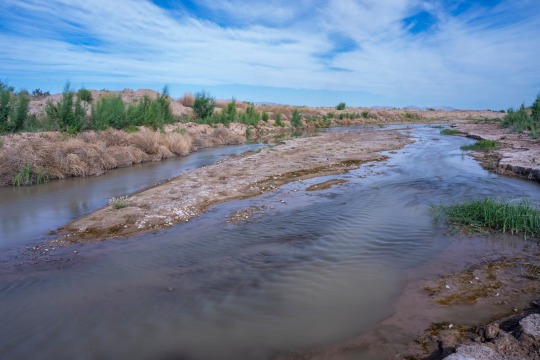
The Rio Grande is dotted by dry stretches throughout Texas.
The Rio Grande supports more than 16 million people in the US and Mexico, including 22 indigenous nations. Alarmingly, this vital river system in North America is vanishing at a dramatic rate. Flowing from the Rocky Mountains and later forming the U.S.-Mexico border, this threatened river and its ecosystems have been impacted by agriculture withdrawals, rising temperatures, and unprecedented drought.
“The Rio Grande, just east of El Paso, is the ‘forgotten reach’—by the time it gets here it's a ghost of its former self. Because of a changing climate, severe drought, and asking too much of this limited resource, it's completely drying out.”
— Pete McBride, National Geographic Photographer and Explorer
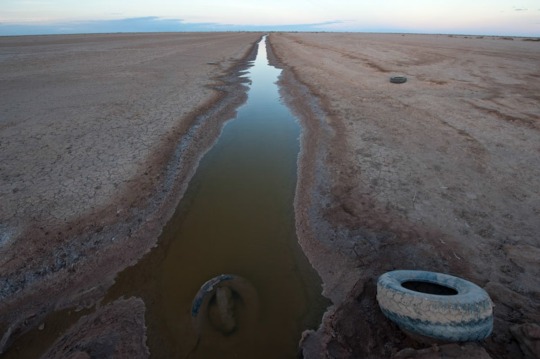
The Rio Grande has seen devastating impacts from climate change. New Mexico, like much of the West, has been battling unusually hot and dry weather for the last two decades. The river has also been hit by historic drought, with the lower Rio Grande, the border between Texas and Mexico, dried up for over a hundred miles.
“Fresh water is one of the most important, limited natural resources,” says McBride as he stands in the barren riverbed. “We can live without oil; we can't live without water.”
America’s Most Endangered River—The Mighty Colorado
Seeing firsthand his own home dry-up in the water crisis had a major impact on the National Geographic Photographer: “I grew up on the [Colorado] River, so I always had a fond love for its beauty and wonder. When I followed it to its end and saw it run completely dry, I realized there needed to be more voices speaking on behalf of the river itself.”
The “lifeline of the West,” as the Colorado River is known, supplies drinking water to 40 million people in the U.S., fuels hydropower in eight states, and is a critical resource for 30 tribal nations and agricultural communities, according to the Bureau of Reclamation. It’s also the most at-risk river in the U.S. and is now considered the most endangered river in the world by conservation nonprofit American Rivers. The once mighty Colorado River has been drying out for the last twenty years due to overuse and historic drought.

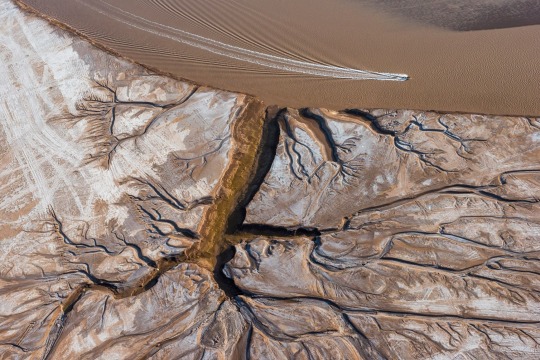
Due to overallocation and climate change, the Colorado River has not reached the sea for two decades.
“The Colorado River is the frontline of climate change,” says McBride. “This remarkable river system supports over 5 million acres of farmland, where 95 percent of our winter vegetables come from. If you like eating salads, you are eating the Colorado River.”
As the climate crisis worsens, the water levels plummet. Today, the Colorado River runs at only 50% of its traditional flow, while its largest reservoirs in the United States: Lake Powell and Lake Meade, fell to 22% during the fall of 2022.
Everyday Actions to Save Water
The water crisis is a daunting and undeniably complex issue, but that doesn’t mean that people in their daily life can’t help protect our most valuable resource. If we don’t take action now, there won’t be time to save these rivers, lakes, reservoirs, and other bodies of water, warns McBride.
“Become more aware of your waterways. Our voices can make a difference. Rivers need more advocates,” advises the National Geographic Explorer, adding, “You can use less water by reducing meat consumption (meat requires a lot of water to produce), using less water-intensive, non-native thirsty plants in your yard, like bluegrass, and reducing how often you run your water systems for dishes, etc. We need agriculture as we need to eat; we just need to become more efficient and mindful about everything: from what is on our plate to how we clean them and use our taps."
McBride believes these are just some of the everyday actions we, as consumers, can take. Another small change that will make a ripple of impact? Use your dishwasher and stop pre-rinsing. Finish agrees. The brand has a longstanding history of driving impact and inspiring change through its ‘Skip the Rinse’ purpose campaign, which encourages consumers to skip pre-rinsing their dishes before placing them in the dishwasher, ultimately saving up to 20 gallons of water each time. If we all skipped the rinse, we could save up to 150 billion gallons of water every year.
Other water-saving actions include turning off the shower/faucet while lathering or brushing teeth and installing a greywater recycling system.
“Our fresh water is a limited resource,” warns McBride. “If we don’t get involved on some level, we will [see] more of that resource vanish.”
#Environment#Waterways Crisis#Rio Grande & Colorado Rivers#U.S. National Geographic Photographer Pete McBride#Kathleen Rellihan#American West#Hopeful Monument#Texas Native Limestone#Rock Formations | Waterflow | Waterfalls | Flora and Fauna#McBride: National Geographic Freshwater Hero#Rio Sand#El Paso#U.S. 🇺🇸/Mexico 🇲🇽 Border#Indigenous Nations#Rocky Mountains ⛰️#Agriculture 👨🌾#Hydropower#Tribal Nations | Agricultural Communities#Overuse of Waters | Historic Drought#United States 🇺🇸: Lake Powell | Lake Meade#National Geographic Explorer#Shower/Faucet#Greywater Recycling System#Resource Vanish
0 notes
Video
youtube
10 Worst Things About The Trump Presidency
Donald Trump left office with the lowest approval rating of any president ever. But some people now seem to be suffering from amnesia.
Let me jog your memory. Here are 10 Worst Things About the Trump Presidency — in no particular order.
#1. Trump fueled division and sparked a record uptick in hate crimes.
#2. Murder went way up under Trump. He presided over the largest ever single-year increase in homicides in 2020. A number of factors might have contributed to that, but a big one is…
#3. Gun sales broke records under Trump, who has bragged about how he “did nothing” to restrict guns as president in spite of…
#4. Under Trump, America suffered more than 1,700 mass shootings.
#5. Trump said there were "very fine people" among the neo-Nazis in Charlottesville.
I’m halfway to ten. If you think I’m missing something big, leave it in the comments.
#6. Trump allied himself with the Proud Boys, a violent hate group who helped orchestrate the Jan 6 Capitol attack.
#7. Trump’s not wrong when he says…
TRUMP: I got rid of Roe v. Wade.
It is entirely because of Trump’s judicial appointments that 1 in 3 American women of childbearing age now lives in states with abortion bans.
#8. One of Trump’s Supreme Court justices was Brett Kavanaugh, a man accused of sexual assault by multiple women.
#9. Trump’s White House interfered in the FBI’s investigation of Brett Kavanaugh’s alleged sexual assaults.
And now: #10. Trump has been convicted of committing 34 felonies while in office. The criminally false business filings he got convicted for in New York? All of them were committed while he was president.
I’m sorry, did I say the 10 Worst Things About the Trump Presidency? I meant 15.
#11. Trump’s failed pandemic response is estimated to have led to hundreds of thousands of needless deaths. By the time Trump left office, roughly 3,000 Americans were dying of covid every day. That’s a 9/11-scale mass casualty event every single day. How did Trump screw up so badly?
#12. Trump’s White House discarded the pandemic response playbook that had been assembled by the Obama administration.
#13. Trump disbanded the National Security Council’s pandemic response team.
#14. Trump repeatedly lied about the danger of covid, saying it was no worse than the flu or that it would go away on its own.
But behind closed doors, Trump admitted he knew covid was deadly.
#15. Trump promoted fake covid cures like hydroxychloroquine and even injecting people with disinfectants.
After Trump’s “disinfectant” remarks, poison control centers received a spike in emergency calls.
That’s fifteen things. Should I keep going? Ok, I’ll keep going. The 20 Worst Things About the Trump Presidency.
#16. Trump presided over a net loss of 2.9 million American jobs — the worst recorded jobs numbers of any U.S. president in history.
#17. Trump profited off the presidency, making an estimated $160 million from foreign countries while he was president.
#18. Trump also billed the Secret Service over $1 million for the privilege of staying at his golf clubs and other properties while they protected him. That’s your money!
#19. Trump caused the longest government shutdown in U.S. history when he didn’t get funding for his border wall, which he said Mexico was going to pay for.
#20. Under Trump, the national debt increased by about 40% — more than in any other four-year presidential term — largely because of his tax cuts for the rich and big corporations.
You didn’t really think I was stopping at 20, did you? We’re going to 25 —
#21. Trump separated more than 5,000 children from their parents at the border, with no plan to ever reunite them, putting babies in cages.
#22. The Muslim Ban. Yes, Trump really did try to ban Muslims from entering the country.
#23. Trump sparked international outrage by moving the American Embassy in Israel to Jerusalem while closing the U.S. mission to Palestine.
#24. Trump tasked his son-in-law Jared Kushner with drafting a potential Middle East “peace plan” with zero Palestinian input.
#25. And finally, Trump recognized Israel’s occupation of the Goh-lahn Heights, which is considered illegal under international law.
So there you have it, folks: The 25 Worst — Wait a minute. Wait a minute. Did I mention the impeachments? We’ve got to do the impeachments. Let’s go to 30.
#26. Trump broke the law by trying to withhold nearly $400 million of U.S. aid for Ukraine in an effort to extort a personal political favor from Ukraine’s Pres. Zelensky. Trump wanted Zelensky to interfere in the 2020 election by announcing an investigation into the Bidens. Delaying this aid to Ukraine weakened Ukraine and strengthened Russia.
#27. Trump personally attacked and ruined the careers of everyone who stood in the way of his illegal Ukraine scheme, including Ambassador Marie Yovanovitch and Lt. Colonel Alexander Vindman.
#28. To cover up the scheme, Trump ordered the White House and State Department to defy congressional subpoenas.
#29. For these reasons, on December 18, 2019, Trump became the third U.S. president to be impeached. He was charged with Abuse of Power and Obstruction of Congress.
#30. Even while he was being investigated for trying to get Ukraine to interfere in the U.S. election, Trump publicly called for China to interfere in the election.
So those are the 30 Worst Things —
I’ll go to 35.
#31. Long before Election Day, Trump started making false claims that the election would be rigged.
#32. After losing, Trump falsely claimed the election was stolen, even though his own inner circle, including his campaign manager, White House lawyers, and his own Justice Department and attorney general told him it was not.
#33. Trump kept telling his Big Lie even after more than 60 legal challenges to the election were struck down in court, many by Trump-appointed judges.
#34. Trump ordered the Department of Justice to falsely claim that the election “was corrupt.”
#35. Trump and his allies used threats to pressure state leaders in Arizona and Georgia to falsify the election results.
We may go to 40.
#36. When none of the previous schemes worked, Trump and his allies produced fake electoral votes cast by fake electors in multiple swing states. His former White House chief of staff and Rudy Giuliani are among the many members of his inner circle who have been criminally indicted for this scheme.
#37. Trump tried to bully Vice President Pence into obstructing the certification of the election.
#38. Trump invited a mob to the Capitol on Jan 6 with his “be there, will be wild” tweet.
#39. Sworn testimony alleges that when Trump was warned that members of the crowd were carrying deadly weapons, he ordered security metal detectors to be taken down.
#40. Knowing the crowd had deadly weapons, he ordered them to go to the Capitol and…
TRUMP: …fight like hell.
#41 — Yes, yes, I know, bear with me.
Trump betrayed his oath to defend the nation by doing nothing to stop the Jan 6 violence. Instead, according to witness testimony, he sat and watched TV for hours.
#42. On January 13, 2021, Trump became the only president ever to be impeached twice. This time he was charged with incitement of insurrection. It was a bipartisan vote.
#43. The majority of senators — 57 out of 100 — voted to convict Trump, including 7 Republican senators.
So that’s the two impeachments and the Big Lie, but wait, we haven’t dealt with Russia, right? So we’re going to 50.
#44. In a likely obstruction of justice, Trump pressured then FBI Director James Comey to stop the FBI’s investigation into Trump’s National Security Adviser, Michael Flynn. This was documented in the Mueller report.
#45. When Comey didn’t bend to Trump’s will, Trump fired him.
#46. Trump tried to shut down the Mueller investigation by ordering White House Counsel Don McGann to fire Mueller. McGann refused because that would be criminal obstruction of justice.
#47. When news got out that Trump tried to fire Mueller, Trump repeatedly told McGann to lie — to Mueller, to press, to public — and even create a false document to conceal Trump’s attempt to fire Mueller.
#48. Trump ordered his staff not to turn over emails showing Don Jr. had set up a meeting at Trump Tower before the 2016 election with representatives of the Russian government.
#49. Trump convinced Michael Cohen to lie to Congress about Trump’s plans to build a Trump Tower in Moscow, and Cohen served prison time for lying to Congress.
#50. Trump was not charged for criminal obstruction of justice because it’s the Justice Department’s policy not to indict a sitting president, but more than a thousand former federal prosecutors who served under both Republicans and Democrats, signed a letter declaring there was more than enough evidence to prosecute Trump.
So those are the 50 Worst Things About the Trump Presidency. Now I could go on…
And I will! The 75 Worst Things About the Trump Presidency.
#51. Trump said he’d hire only the best people, but…
His campaign chair was convicted of multiple crimes.
So was one of his closest associates.
His deputy campaign chair pleaded guilty to crimes.
So did his personal lawyer
His National Security Adviser
The Chief Financial Officer of his business
A campaign foreign policy adviser
And one of his campaign fundraisers.
They all committed crimes, and Trump pardoned most of them.
#52. Trump said he’d drain the Washington swamp. But he appointed more billionaires, CEOs, and Wall Street moguls to his administration than any administration in history
#53. Trump intervened to get his son-in-law, Jared Kushner top-secret clearance after he was denied over concerns about foreign influence.
#54. Trump hosted a Russian Foreign Minister to the Oval Office, where Trump revealed top-secret intelligence.
Oh, and Trump’s economic policies!
#55 Trump promised that the average American family would see a $4,000 pay raise because of his tax cuts for the wealthy and big corporations. How’d that work out? Did you get a $4,000 raise? Of course not! Nobody did!
#56. Trump vowed to protect American jobs, but offshoring increased and manufacturing fell.
#57. Trump said he would fix America’s infrastructure, but it never happened. He announced so many failed “infrastructure weeks” they became a running joke.
#58. Trump said he would be “the voice” of American workers, but he filled the National Labor Relations Board with anti-union flacks who made it harder for workers to unionize.
#59. Trump’s Labor Department made it easier for bosses to get out of paying workers overtime, which cheated 8 million workers of extra pay.
#60. Trump repeatedly suggested he might serve more than two terms in violation of the Constitution — and continues to do so.
#61. Trump called Haiti and African nations “shithole” countries.
#62. Trump tried to terminate DACA, which protects immigrants brought to the U.S. as children. Luckily this was struck down by the courts.
#63. Trump called climate change a “hoax.”
#64. Trump pulled out of the Paris Climate Agreement.
#65. Trump rolled back more than 100 environmental protections.
#66. Every budget Trump proposed included cuts to Social Security and Medicare.
#67. Trump tried (and failed) to repeal the Affordable Care Act, which would have resulted in 20 million Americans losing insurance. And striking down the ACA’s protections for the roughly 130 million people with pre-existing conditions could have driven up their insurance premiums or led to a loss of coverage.
#68. Trump made it easier for employers to remove birth control coverage from insurance plans.
#69. By the end of Trump’s term, the number of people lacking health insurance had risen by 3 million.
#70. Trump lied. Constantly. He made 30,573 false or misleading claims while president — an average of 21 a day, according to Washington Post fact-checkers.
#71. Trump allegedly took hundreds of classified documents on his way out of the White House, reportedly including nuclear secrets, which he then left unsecured in various parts of Mar-a-Lago, including a bathroom. He was even caught on tape showing them off to people.
#72. Trump seriously discussed the idea of nuking a hurricane.
#73. When Hurricane Maria hit Puerto Rico, Trump delayed $20 billion of aid and allowed Puerto Rico to be without power for 181 days.
#74. Trump suggested withholding federal aid for California wildfire recovery and said the solution was to “clean” the “floors” of the forest.
#75. Trump pulled out of the Iran deal, placing Iran on a path to developing nuclear weapons.
Honestly, there’s so much more, from exchanging “love letters” with North Korea’s brutal dictator to publicly denigrating a Gold Star military widow and making her cry, to the way he attacked journalists, to late night tweet binges.
Look, I can understand why a lot of people want to block all of this out of their memories. But we cannot afford to forget just how terrible Trump’s time in the White House was for this nation.
And we sure as hell can’t afford to put him back there.
1K notes
·
View notes